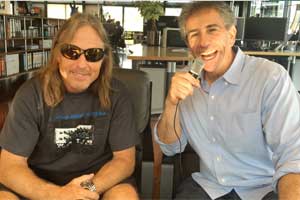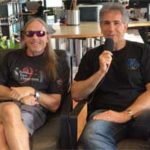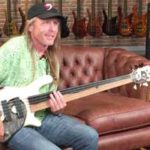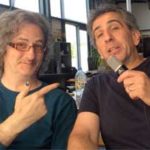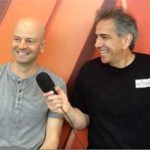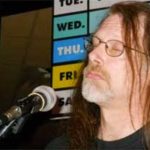Everybody’s favorite bass player talks about the styles, the sessions, his bass collection and, of course, surfing!
Exclusive interview with FBPO’s Jon Liebman
February 14, 2011
Bass player (and surfing fanatic) Steve Bailey began playing bass at age 12. Steve took to the upright bass after hearing Chick Corea’s Light As a Feather, then to the fretless after running after over his fretted bass with his car! After hearing Jaco Pastorius and Stanley Clarke, Steve began practicing his bass twelve hours a day, putting his surfing career on hold indefinitely. Bailey received full scholarships to North Texas State University (where, he says, he played lots of upright) and University of Miami (where he played lots of electric).
Throughout his brilliant career, Steve has worked alongside a veritable who’s who of musical luminaries, cutting across virtually all genres of musical styles. He has performed and/or recorded with beboppers Dizzy Gillespie, James Moody and Lew Tabackin; Latin jazz stars Paquito D’Rivera, Claudio Roditti and Michel Camilo; smooth jazzers David Benoit, the Rippingtons and Kilauea; rockers Jethro Tull, Lynyrd Skynrd and Jon Anderson; country crooners Willie Nelson, Ray Price and Billy Joe Shaver; fusion artists Larry Carlton, Emily Remler and Brandon Fields; New-agers Kitaro, Max Highstein and T Lavitz; blues artists Tab Benoit, Johnny Witherspoon and Toni Price; jazz singers Mel Torme, Ernestine Anderson and Mark Murphy; and fellow bassists Victor Wooten (with whom he formed the popular Bass Extremes series), John Patitucci and Billy Sheehan.
Steve was a faculty member of Bass Institute of Technology for ten years. He has also served as Artist-in-Residence at Coastal Carolina University, an advisory board member and columnist for Bass Player magazine and faculty member of the National Guitar Summer Workshop. Steve remains active as a bass soloist and clinician worldwide.
FBPO: What kind of musical upbringing did you have? How did you become a bass player?
SB: I played trombone and piano a little before I started playing bass at age 12. A friend in junior high, Jim Van Buskirk, came up to me and asked if I would play bass in his band. He said he had a gig in a few weeks and there would be girls there. I played “All Along the Watchtower” with them and the next thing I knew, I was in the band! Jim, by the way, went on to develop GigaStudio, one of the most innovative pieces of digital/recording gear in history.
FBPO: You seem equally adept at fretted, fretless, 5-string, 6-string, upright, arco, etc. I get the sense you took to the bass quite naturally. Am I right, or did you have to work extra hard at it?
SB: I fell in love with the bass the first day I played it. Soon afterwards, I knew what I wanted to do for the rest of my life. When I found out that I might be able to make a living at it, I got even more excited. Then I fell in love with upright, then fretless and… there were just not enough hours in the day! I still work hard at it, although I feel “natural” at the bass, and a few other things, like surfing and tennis. But they all require a lot of work.
FBPO: I can’t recall ever hearing you referred to as a “conventional” bass player, given the exotic instruments, unique fingerings, expanded harmonies and the other things for which you’re known. How did you develop your style(s)?
SB: Surprisingly, most of the bass playing I have done over the years has been conventional. My lifestyle was built on playing sessions for albums, jingles, etc., most all of them “conventional.” The other stuff I became known for kind of got started back when I was working with Dizzy Gillespie. We went on the road without a pianist or guitarist, so the responsibility of filling up the harmony was left to me. That’s when all the artificial harmonics and chords got put to use. It was stuff I just practiced because I had an early goal of being able to back up a singer at the local Holiday Inn with no other accompaniment. Never got that gig!
FBPO: With all the gigs, tours, recording sessions and everything else you’ve done, you must have had the occasional “interesting experience” or two. Anything come to mind? Perhaps a good road story?
SB: [Laughs] Guys at our bass camps love my road stories, Jaco stories, running over my bass stories, getting fired/hired stories, almost losing my life on the way to the gig stories, Dizzy farting on stage stories, etc.
FBPO [Laughing]: Tell me about some of the books and other educational resources you’ve developed.
SB: My first book series included Rock Bass, Fretless Bass, Five-String Bass, Six-String Bass and Advanced Rock Bass. My first video was Advanced Bassix, followed by Fretless Bass, which ties together with the “fretless” book. Probably the most popular of all was Bass Extremes, which I did along with then-newly emerging Victor Wooten, around 1993 or ’94. We made a live video of that around the same time, as well as a couple of albums after that. Vic and I also launched the Bass Vault, an educational video-based website. Rock Bass and Fretless Bass have been re-released in the last two years.
FBPO: As an educator, how do you help your students find the balance between wanting to be a great player, on the one hand, and preparing to make a living as a musician, on the other?
SB: I teach the fundamentals of solid bass playing, first and foremost. That pays the bills. I also have them develop their solo bass skills, but it all needs to be built on a solid foundation.
FBPO: Tell me about your bass camp.
SB: My camp is called “Bass at the Beach.” Compared to the Bass/Nature camps I do with Vic, Bass at the Beach is like Club Med for bass players! I have been so busy that in the last couple of years we have not done Bass at the Beach, but I continue to do Bass/Nature camps throughout each year.
FBPO: What’s your “bass arsenal” these days? I assume you have an old-fashioned Fender-style 4-string in your collection somewhere, but what else do you have that would be of interest to our readers?
SB: Goodness, I have a lot of basses! Old Fenders, newer basses, old Warwicks, one of which is a 12-string (6×2). I also have some new Warwicks and Alien acoustic bass guitars. The prizes of my collection are: 1) Stanley Clarke’s “Red Bass,” which was used on Return to Forever records, Clarke/Duke projects and tours; and 2) Anthony Jacksons #1, the first 6-string contrabass guitar made by Carl Thompson. I have a few others that are very special to me, as well.
FBPO: What’s keeping you busy these days?
SB: I have a recording studio, where I have been producing and writing a good bit. I also have my university work, clinics, recording sessions via Internet… and raising an 8-year-old!
FBPO: Last question: Still surfing?
SB: I will always be surfing. I live at the ocean and feel the most comfortable where I can see, hear, feel and smell the ocean!
